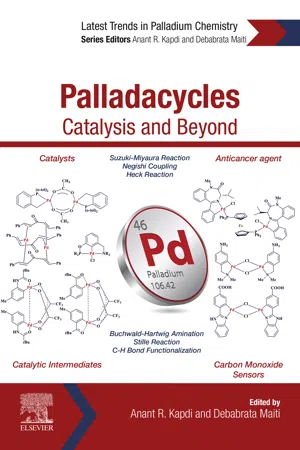
- 420 pages
- English
- ePUB (mobile friendly)
- Available on iOS & Android
About This Book
Palladacycles: Catalysis and Beyond provides an overview of recent research in palladacycles in catalysis for cross-coupling and similar reactions. In the quest for developing highly efficient and robust palladium-based catalysts for C-C bond formation via cross-coupling reactions, palladacycles have played a significant role. In recent years, they have found a wide variety of applications, ranging from catalysts for cross-coupling and related reactions, to their more recent application as anticancer agents. This book explores early examples of the use of palladacyclic complexes in catalysis employing azobenzene and hydrazobenzene as coordinating ligands. Its applications in processes such as selective reduction of alkenes, alkynes, or nitroalkanes are also covered.
Palladacycles: Catalysis and Beyond reveals the tremendous advances that have taken place in the potential applications of palladacycles as versatile catalysts in academia and industry. It is a valuable resource for synthetic chemists, organometallic chemists, and chemical biologists.
- Reviews the importance and various applications of palladacycles in academic research and industry, including industrial scale applications
- Includes the impact of palladacycles on coupling reactions and potential applications as anticancer agents
- Features coverage of nano and colloidal catalysis via palladacyclic degradation
Frequently asked questions
Information
Palladacycles as Efficient Precatalysts for Suzuki-Miyaura Cross-Coupling Reactions
Abstract
Keywords
1 Introduction


Table of contents
- Cover image
- Title page
- Table of Contents
- Copyright
- Contributors
- Chapter 1: Palladacycles as Efficient Precatalysts for Suzuki-Miyaura Cross-Coupling Reactions
- Chapter 2: Palladacycles as Precatalysts for Heck and Sonogashira Cross-Coupling Reactions
- Chapter 3: Palladacycles as Efficient Precatalysts for Negishi and Buchwald-Hartwig Amination Reactions
- Chapter 4: Introduction of Water-Solubility in Palladacycles and Their Catalytic Applications
- Chapter 5: Palladacyclic Complexes as Efficient Catalysts for CH Bond Functionalization Reactions
- Chapter 6: Multicomponent Reaction Sequences Using Palladacyclic Complexes
- Chapter 7: Enantioselective Synthesis Using Chiral Palladacycles
- Chapter 8: Nanoparticular or Colloidal Pathways for Palladacycles-Mediated Catalytic Processes
- Chapter 9: Palladacycles as Potential Anticancer Agents
- Chapter 10: Miscellaneous Applications of Palladacycles
- Index